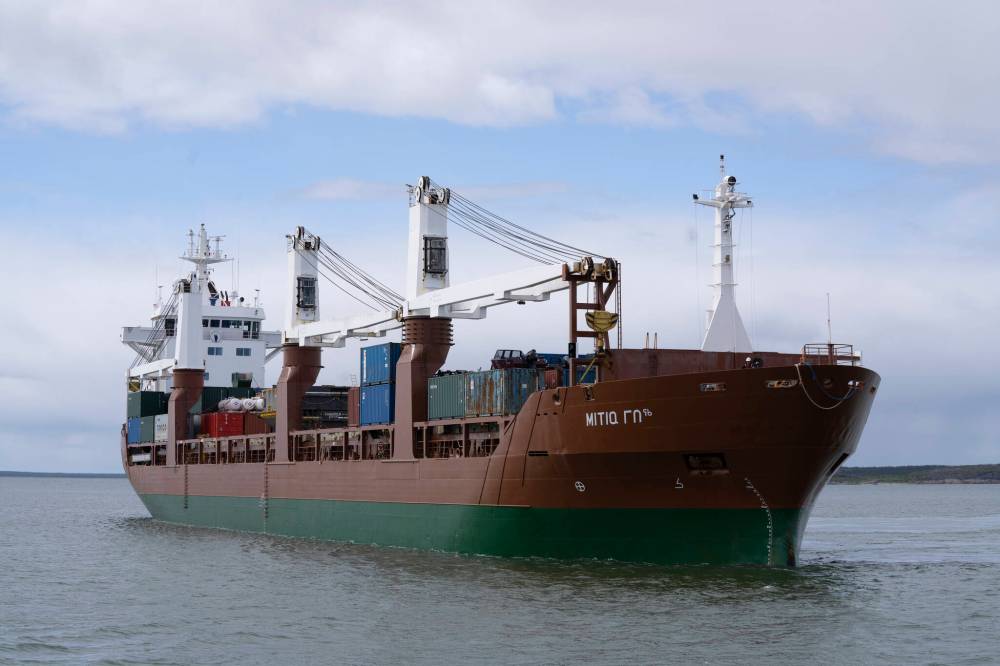Arctic Gateway Group inks MOU with Fednav, eyes on year-round port access
Advertisement
Read this article for free:
or
Already have an account? Log in here »
To continue reading, please subscribe:
Monthly Digital Subscription
$0 for the first 4 weeks*
- Enjoy unlimited reading on winnipegfreepress.com
- Read the E-Edition, our digital replica newspaper
- Access News Break, our award-winning app
- Play interactive puzzles
*No charge for 4 weeks then price increases to the regular rate of $19.00 plus GST every four weeks. Offer available to new and qualified returning subscribers only. Cancel any time.
Monthly Digital Subscription
$4.75/week*
- Enjoy unlimited reading on winnipegfreepress.com
- Read the E-Edition, our digital replica newspaper
- Access News Break, our award-winning app
- Play interactive puzzles
*Billed as $19 plus GST every four weeks. Cancel any time.
To continue reading, please subscribe:
Add Free Press access to your Brandon Sun subscription for only an additional
$1 for the first 4 weeks*
*Your next subscription payment will increase by $1.00 and you will be charged $16.99 plus GST for four weeks. After four weeks, your payment will increase to $23.99 plus GST every four weeks.
Read unlimited articles for free today:
or
Already have an account? Log in here »
Leadership behind the Port of Churchill has struck a deal to explore year-round shipping with a global company.
Currently, boats can enter the northern Manitoba port during a four-month window (July through October).
Arctic Gateway Group, the port’s owner, has inked a memorandum of understanding with Fednav, Canada’s largest international dry bulk shipping company, to evaluate whether 12-month operations are sustainable.

SUPPLIED / FREE PRESS FILES
Currently, boats can enter Churchill during a four-month window (July through October).
“We believe that having year-round access to the Port of Churchill is a possibility,” said Chris Avery, Arctic Gateway Group’s chief executive.
The Hudson Bay’s ice-free season is continually extending. Meantime, the provincial and federal governments are funnelling money into the site, touting it as a route to markets like Europe.
Fednav has technology to ship through ice, Avery said. The Montreal-based company counts around 120 vessels and delivers more than 30 million tonnes of cargo annually.
“The Arctic is a core part of our business,” said Stéfany Corey, Fednav senior manager of communications. “We ship year-round everywhere that we go.”
Partnering with Arctic Gateway Group seemed like a “logical exploration,” Corey continued. Both parties will bring members to a working group. The cluster will meet monthly starting in October, Corey said.
She wouldn’t detail the types of shipments Fednav might ferry through the Port of Churchill. Fednav has contracts with mining partners, she added.
It was attracted to Churchill because of the work Arctic Gateway Group has been doing in the area and the organization’s “strong ties” with community, Corey said.
Forty-one Indigenous and Bayside communities make up Arctic Gateway. It’s been revitalizing the port and the Hudson Bay Railway since taking ownership in 2018.
Arctic Gateway Group and the federal government are co-funding a study on how many months the Hudson Bay is navigable for shipping. Insurance premiums increase “exponentially” for companies trying to ship outside of July through October, Avery relayed. “We believe that the insurance companies are operating off of decade-old data.”
Providing insurance companies with new data from the University of Manitoba could decrease rates in shoulder seasons, Avery continued.
On average, the Hudson Bay has seen another ice-free day per year since the 1980s. This has totalled a new month without ice when comparing today to the 1980s, said Feiyue Wang.
Wang is the Canada Research Chair in Arctic environmental chemistry. The University of Manitoba professor is part of a team behind the new shipping study.
The preliminary report should be ready within months, but it must go through a peer review process before publication. The latter process could take up to a year, Wang said.
Past research from the U of M’s Centre for Earth Observation Science, which Wang is part of, has forecast the Hudson Bay will become “essentially ice-free” by the end of the century.
“From a scientist point of view, definitely, the bay is becoming more open,” Wang said. “We will see a much longer shipping season from Churchill.”
Wang echoed a phrase Premier Wab Kinew has touted, calling Manitoba a “maritime province.”
Arctic Gateway Group announced in July it was doubling the number of weekly freight trains along the Hudson Bay Railway and tripling storage capacity of critical minerals this year.
The railway connects The Pas to Churchill. The Port of Churchill is Canada’s only deep-water Arctic port connected to a North American surface transportation network.
The season’s first shipment of zinc concentrate was being loaded Friday, Avery said. He expects upwards of 20,000 tonnes of zinc concentrate to move through the port this year.
Last summer marked the return of critical mineral shipments in more than 20 years; the port saw 10,000 tonnes of zinc concentrate. (The federal government deems zinc a critical mineral.)
gabrielle.piche@winnipegfreepress.com

Gabrielle Piché reports on business for the Free Press. She interned at the Free Press and worked for its sister outlet, Canstar Community News, before entering the business beat in 2021. Read more about Gabrielle.
Every piece of reporting Gabrielle produces is reviewed by an editing team before it is posted online or published in print — part of the Free Press‘s tradition, since 1872, of producing reliable independent journalism. Read more about Free Press’s history and mandate, and learn how our newsroom operates.
Our newsroom depends on a growing audience of readers to power our journalism. If you are not a paid reader, please consider becoming a subscriber.
Our newsroom depends on its audience of readers to power our journalism. Thank you for your support.


